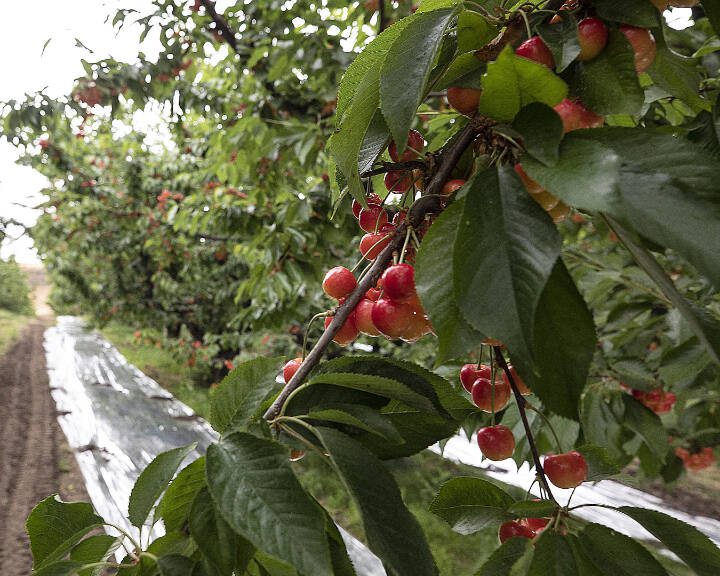By Trevor Cameron / The Golfing Gardener
Editor’s Note: This column is provided by Sunnyside Nursery in Marysville in place of the weekly Whistling Gardener column by Steve Smith, who is taking the week off.
As we continue our discussion on the home orchard this week, let’s dig into some more specifics on growing fruit successfully in Western Washington. After reading last week’s column, I am hoping you are doing some planning and considering your own pertinent questions.
We are lucky to have two prominent “ag” schools in the Pacific Northwest that continue to develop, test and report on specific fruit tree varieties: Washington State University and Oregon State University. Both have numerous research facilities in the Pacific Northwest — one WSU location is right up in Mount Vernon — continually running trials on what grows best here and evaluating new varieties for Western Washington and Oregon. Thanks to them, amongst others, we have some great varieties to choose from for our specific climate that often show superior disease resistance and more reliable production year after year.
Remember to be honest with your gardening-self and make varietal choices that will match your anticipated time constraints. Will you spray properly or leave these fruit-bearing beauties to Mother Nature’s whims and desires? “Resistant” never means immune, but your chances of a disease-free, lower-maintenance orchard will exponentially increase with the right choices. Allow your trees to flourish by giving them space to do so. Dimensions will vary a bit on some, but almost all fruit trees need a minimum circle of 15 feet to 20 feet in order to thrive, so plan accordingly. Closer together means more pruning, along with less sun and air circulation, which inevitably leads to more disease issues, in my opinion.
For help getting proper diagnoses of any issues, always visit your local nursery professional for advice on which products will be both safe and effective in your home orchard. For starters, a good dormant spray this time of year will help, and with few exceptions a mixture of OMRI listed Horticultural Oil and Liquicop (copper fungicide) is as effective as anything for both insects and diseases.
In the growing season, one of the easiest products to have on hand is Home Orchard Spray from Bonide — part of the Captain Jack line of natural products that control a number of diseases and insects, all in one spray. One simple practice to consider, that will make a huge difference in both bug and disease issues year to year, is cleaning up your trees. Diseased foliage and old, rotting fruit stuck in trees or lying on the ground through winter is just asking for the same issues to come back once again the following season.
Now let’s look at some specific varieties to consider adding to your yard.
Apples: For disease resistance, Liberty is at the top, followed closely by Spartan, Chehalis and Pristine. The most popular these days are Cosmic Crisp and Honeycrisp, which will grow well but may need a little spraying to keep them clean. Remember, when choosing apples, you always need two different compatible varieties to cross-pollinate — without exception.
Cherries: There are a number of excellent self-fertile sweet cherries to choose from for Western Washington, including Glacier, Sweetheart, Lapin, Black Gold and Tehranivee. Rainier is the one popular flavor that does need a second variety for pollination. Keep in mind that all pie cherries are both self-fertile and excellent pollinators, which helps get bees into the orchard.
Pears: There is a wide range of both European-type and Asian-type pears available, both of which require cross-pollination (two different varieties needed). All pears will produce in our area, but for increased disease resistance consider Moon Glow, Early Gold, Ubileen, Maxie and Reddy Robin. Classics such as Bartlett, Orcas and Rescue, as well as others, are good too.
Peaches/Apricots/Nectarines: Top consideration for varieties of these is disease resistance, period. All of them should definitely be monitored and sprayed each season, but the most resilient choices are Frost or Salish Summer (peaches), Puget Gold or Harglow (apricots), and Hardy Red (nectarine). All other flavors are going to struggle locally, in all honesty.
Plums: You can choose from oval-shaped European-type plums (self-fertile), such as the classic Italian, Imperial Epineuse, or Yellow Egg, or larger, round Japanese-type plums such as Beauty, Shiro or Satsuma, which are all tasty but need cross-pollination (two varieties needed).
Whether you are adding to an existing orchard or starting anew, I hope you explore these recommendations. Contemplate fun and nutritious trees such as figs, persimmons or mulberries. Perhaps add some nuts such as hazelnuts, walnuts or hardy almonds to have a seasonal feast right in your own backyard.
Maximum selection is now available at the local nurseries, and many are running bare root sales, which saves you money and makes transporting them home easy. The perfect time to plant is now, so get out there and do some planning, ask some questions, consider your options and ultimately start growing your own fruit.
Free class
Sunnyside Nursery in Marysville will host “DIY Terrariums” at 10 a.m. on Saturday, Feb. 10. For more information or to sign up, go to www.sunnysidenursery.net/classes.
Trevor Cameron is a certified professional horticulturist (CPH) and serves as general manager for Sunnyside Nursery in Marysville. He can be reached at sunnysidenursery@msn.com.
Talk to us
> Give us your news tips.
> Send us a letter to the editor.
> More Herald contact information.


























